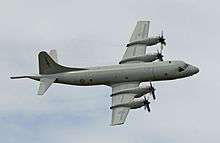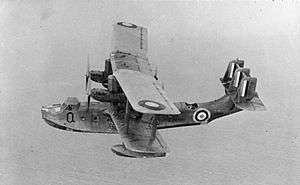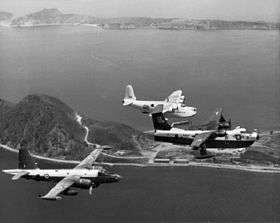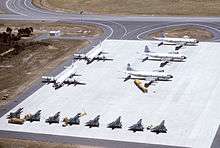No. 5 Squadron RNZAF
| No. 5 Squadron RNZAF | |
|---|---|
|
Squadron insignia | |
| Active |
November 1941 – November 1942 July 1944 – present |
| Country |
|
| Branch |
|
| Role | Anti-ship/Anti-submarine operations, Maritime patrol, Search and rescue |
| Garrison/HQ | RNZAF Base Auckland |
| Motto(s) |
Fiji: Keitou Kalawaca Na Wasaliwa (Translation: We span the ocean) |
| Colors | Black and White |
| Mascot(s) | Albatross |
| Anniversaries | 03 November |
| Equipment | 6 x P-3K2 Orions |
| Engagements |
World War II Operation Enduring Freedom |
| Commanders | |
| Current commander | Wing Commander Daniel Hunt |
| Insignia | |
| Squadron Badge | In front of a blue roundel, an Albatross volant facing sinister with its wings spread in flight |
| Squadron Codes |
OT (Nov 1941 – Nov 1942)[1] PA (Jul 1944 – 1945)[1] KN (1946–1955)[1] |
No. 5 Squadron RNZAF is a squadron of the Royal New Zealand Air Force formed during November 1941 in Fiji. It remains on active duty and logged 2,300 hours flight time in 2007.[2]
History
World War II
Initially, the squadron was equipped with Vickers Vincents. From the outbreak of hostilities with Japan, the squadron operated the Short Singapore Mk.IIIs (transferred on October 1941 from No. 205 Squadron RAF ) mainly on maritime patrol and anti-submarine duties, rescueing more than fifty survivors of ditched aircraft[3] and successfully attacking a Japanese submarine in the process with the elderly Singapores. These types were superseded by Consolidated PBY Catalinas, which aided the air-sea rescue capability. The Squadron moved from Fiji in late 1944 to operate between Espiritu Santo and the Admiralty Islands. During this time the later conqueror of Mount Everest, Edmund Hillary, served with the squadron.[4] In November 1944 the squadron moved to Luganville Seaplane Base on Espiritu Santo to carry out anti-submarine patrols and escort duty[5] In August 1945 the squadron was withdrawn to Fiji.[6]
Cold war
Following the war the squadron was re-equipped with 16 Short Sunderland MR.5s and based at Laucala Bay, in the suburbs of Suva, Fiji, tasked with "maritime surveillance" over the vast South Pacific Ocean, medical evacuation flights and communications flights for the colonial administrators". From 1965 the squadron relocated to Whenuapai, Auckland, to re-equip with five Lockheed P-3B Orions in the anti-submarine role. The squadron withdrew its last flight of Sunderlands from Lauthala Bay in 1967.
The P-3B fleet was upgraded in the mid 1980s (Project Rigel) with a more modern radar (APS-134), an IRDS camera, a digital computing bus and electronic displays/information management system. They were subsequently redesignated P-3K. A sixth aircraft was purchased from the RAAF during the Project Rigel upgrade.
No. 5 Squadron won the Fincastle Trophy for anti-submarine work on a number of occasions, although in recent years the focus has shifted from anti-submarine warfare to broader maritime patrol and search and rescue missions.
Twenty-first century

The aircraft have been deployed to assist international efforts on several occasions. From May 2003 to February 2004, a detachment operated in support of Operation Enduring Freedom by patrolling the Arabian Sea and Gulf of Oman.
In October 2004, a contract was signed with L-3 Communications Integrated Systems, of the United States, to upgrade the aircraft’s communication, navigation, surveillance and data management systems.[7] The contract also included an upgrade of crew training, software testing and integration facilities and mission preparation and analysis systems.
In 2005 the first of the six P-3K Orions began being upgraded to the new P-3K2 standard, modernising the avionics and mission systems.
In January 2006 No. 5 Squadron conducted trials to prove the aircraft could operate from Antarctica. This would improve capabilities to better police illegal fishing, and the trial occurred at a time when New Zealand was under pressure to intervene in the increasingly heated dispute between Greenpeace, Sea Shepherd Conservation Society and Japanese commercial whaling ships.
In 2006 an Orion was used to photograph Raoul Island after a small volcanic eruption killed a Department of Conservation (DOC) worker.
On the 2 May 2011 the RNZAF accepted the first upgraded P-3K2 Orion from the Ministry of Defence. The aircraft is due to undergo a period of Operational Testing and Evaluation (OT&E) before commencing active use.
Following the disappearance of Malaysian Airlines flight MH-370 in March 2014, an RNZAF P-3K2 Orion was deployed to RAAF Base Butterworth to assist with the search for the Boeing 777. The Orion aircraft and crew was then re-tasked and conducted their operations from RAAF Base Pearce near Perth, Western Australia, searching the Southern Indian Ocean for MH-370 alongside other international aircraft and crews.
As of March 2015 all six RNZAF P-3K2 Orions are fully operational after their comprehensive upgrades.[8]
Photo gallery
 The Short Singapore III flying boat.
The Short Singapore III flying boat.- No. 5 Sqn Consolidated Catalinas.
- A No. 5 Sqn Catalina in the immediate post war period.

- An ex-No. 5 Sqn Sunderland at New Zealand's Museum of Transport and Technology (MoTaT).
 No. 5 Sqn P-3Bs during a 1982 exercise with USN and RAAF units.
No. 5 Sqn P-3Bs during a 1982 exercise with USN and RAAF units.
References
- Notes
- 1 2 3 Flintham and Thomas 2003, p. 141.
- ↑ Mateparae, Jerry (8 September 2008). "Can't fight? In fact we still punch above our weight". www.nzherald.co.nz. The New Zealand Herald. Retrieved 25 March 2011.
- ↑ Darby 1978, p. 20.
- ↑ "Sir Edmund Hillary". Air Force News (89). New Zealand Defence Force. February 2008. Retrieved 10 July 2015.
- ↑ Ross 1955, p. 277
- ↑ Ross 1955, p.314
- ↑ "P3 Systems Upgrade [Ministry of Defence NZ]". Defence.govt.nz. 2013-06-21. Retrieved 2013-10-22.
- ↑ Royal New Zealand Air Force (2 May 2011). "Air Force welcomes upgraded P-3K2 Orion" (Press release). Archived from the original on 6 February 2013. Retrieved 10 July 2015.
- Bibliography
- Darby, Charles (1978). RNZAF: The First Decade, 1937–46. Dandenong, Victoria: Kookaburra Technical Publications. ISBN 0-85880-031-4.
- Flintham, Vic; Thomas, Andrew (2003). Combat Codes: A Full Explanation and Listing of British, Commonwealth and Allied Air Force Unit COdes Since 1938. Shrewsbury, Shropshire, UK: Airlife Publishing. ISBN 1-84037-281-8.
- Ross, John (1955). Royal New Zealand Air Force. Historical Publications Branch. ISBN 0898391873.
Further reading
- Harrison, Paul (2006). Kiwi Orions. Paraparaumu, New Zealand: Kiwi Air Research. ISBN 9780473113612.
External links
- RNZAF Web site 5 Squadron page
- Culpan, Pete. "5 Squadron RNZAF Association". www.5sqnassn.org.nz. 5 Squadron RNZAF Association. Retrieved 25 March 2011.